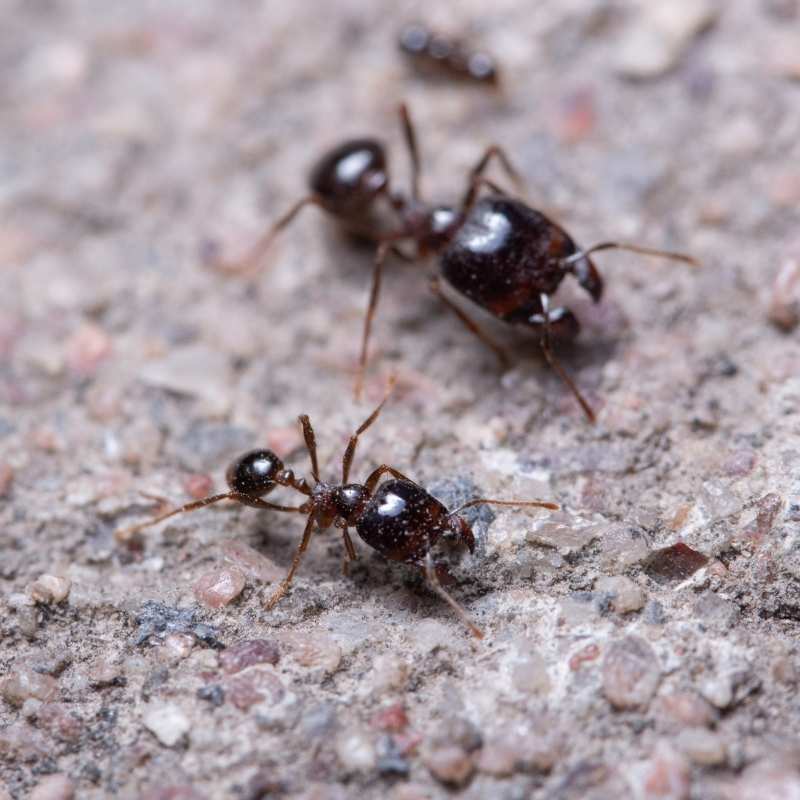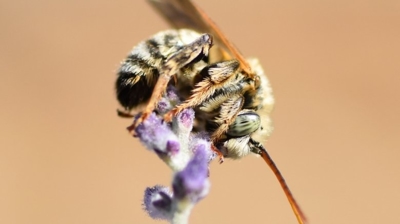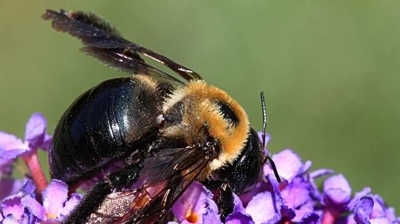
Bigheaded Ant Control Services

Bigheaded Ants
Bigheaded ants (Pheidole spp.) can be considered harmful in several ways, though they are not generally considered dangerous to humans:
- No stings or venom: Bigheaded ants do not sting and rarely bite, and they are not a direct medical threat to humans or pets.
- Indirect health concerns: However, they can spread bacteria as they forage, particularly in unsanitary areas like garbage, pet bowls, or drains, and then travel across food preparation surfaces. This creates a potential vector for disease, albeit a relatively low-risk one compared to cockroaches or flies.
- Infestation of homes and buildings: Bigheaded ants frequently invade structures in search of food and water. Once inside, they become a persistent nuisance due to their large colony sizes and aggressive foraging behavior.
- Multiple nesting sites: They often form supercolonies with interconnected nests, making eradication challenging and increasing the likelihood of structural invasion.
- Soil displacement: Their extensive underground nesting can disturb landscaping, displace pavers, weaken foundations, and even damage turf. This is particularly problematic in urban areas and managed landscapes.
Learn more: Do Bigheaded Ants Bite? || What Do Bigheaded Ants Eat?
Bigheaded Ant Removal
Bigheaded ants may look small and unthreatening, but once they establish a colony on a property, they can create persistent, hard-to-eliminate problems. Removing them quickly is important because their biology and behavior make them unusually disruptive indoors, outdoors, and within structural elements of a home:
- They build large, fast-spreading colonies: Bigheaded ants form sprawling multi-queen colonies that expand rapidly. A small population can turn into a large infestation spread across multiple nesting sites, making the problem more difficult—and more expensive—to eliminate the longer they are allowed to grow.
- They invade kitchens and pantries relentlessly: These ants are highly attracted to proteins, oils, and sweet foods. Once they find a food source inside a home, they recruit workers aggressively and can become a constant presence in cabinets, appliances, and food storage areas.
- They displace and attack native insects: Bigheaded ants are extremely dominant. They outcompete native ant species and can disrupt the local ecosystem. Outdoors, they can overrun lawns, gardens, and landscaped areas, reducing beneficial insect activity.
- Their tunneling can weaken soil and disturb the foundation perimeter: Although they don’t eat wood, their habit of creating extensive underground galleries can undermine soil structure around sidewalks, patios, and foundations. Over time, this can contribute to settling and create uneven ground.
- They create persistent outdoor nuisance activity: Bigheaded ants form dense foraging trails and can take over lawns, compost areas, mulch beds, and pet feeding zones. Their presence becomes highly noticeable, and they can quickly repopulate areas even after a partial DIY treatment.
- Infestations are very difficult to control without targeted products: These ants require specific baits and treatment strategies because their colonies have multiple queens and multiple nesting sites. Incorrect or incomplete treatment often causes colonies to “bud,” splitting into several smaller colonies that spread even farther.
Early removal prevents the infestation from reaching a scale where control becomes complex, costly, and disruptive.
Learn more: How To Get Rid Of Bigheaded Ants
Bigheaded Ant Control
Bigheaded ants may not be as well-known as fire ants or carpenter ants, but they can be just as frustrating and damaging when they infest homes or businesses. Here’s why hiring our professional pest control is the best approach for bigheaded ants :
Our professional pest control specialists have the expertise to correctly identify bigheaded ants, which are often mistaken for other ant species. Accurate identification is critical because these ants have unique nesting habits and behaviors—such as creating large colonies with multiple queens and workers, often nesting both outdoors and indoors. DIY sprays or baits rarely eliminate the entire colony and often make the problem worse by causing the ants to split into satellite colonies (a process called budding).
Our trained exterminators know how to target both visible workers and hidden colonies, using professional-grade products and techniques designed to disrupt the ants’ reproduction cycle. We also understand where bigheaded ants typically nest—in soil, under stones, near foundations, and sometimes inside wall voids—allowing us to apply treatment directly at the source.
Beyond immediate control, our professionals provide preventive strategies to keep bigheaded ants from returning. This often includes sealing entry points, treating exterior soil and perimeter areas, and setting up ongoing protective services to stop re-infestations before they become overwhelming.
By hiring our professional pest control, you save time, avoid the frustration of repeated DIY failures, protect your property from damage, and gain long-term peace of mind with expert solutions tailored specifically for bigheaded ants.
Bigheaded Ant Exterminators
Hiring our local exterminators for bigheaded ants is especially valuable because these ants require precise identification, targeted products, and strategic treatment methods that national chains and DIY options rarely deliver. Bigheaded ants form extremely large colonies with multiple subcolonies connected by underground foraging tunnels, so eliminating just the visible activity never removes the true source. Our local professionals understand how these ants behave in the region’s soils, climates, and common neighborhood construction styles, which directly affects where they nest and how they spread. We also know which localized food sources and environmental conditions are driving the infestation—knowledge that is essential for long-term control.
Our local exterminators typically perform more thorough inspections, track satellite colonies, and use products designed to reach deep, protected nesting sites rather than relying on surface sprays that bigheaded ants easily avoid. We can also return quickly as needed for follow-ups, make real-time adjustments based on how the colony responds, and offer honest, customized recommendations instead of one-size-fits-all national protocols. By choosing our local professionals, you’re getting expertise that is specific to the area, faster service, better communication, and significantly more reliable elimination of a pest that is notoriously difficult to remove with DIY or generic treatment plans. Contact us to learn more about our professional pest control services.
What Do Bigheaded Ants Look Like?
Bigheaded ants, belonging to the genus Pheidole, exhibit notable variations in physical appearance among different members of their colony, depending on their roles. However, when considering the general appearance of these ants, we can focus on their common features.
Typically, adult bigheaded ants range in size from 2 to 4 millimeters, with the notable exception of the "soldier" or "major worker" caste, which can have heads that are significantly larger, sometimes up to twice the size of their bodies. This disproportion between the head and body size is a distinctive characteristic of bigheaded ants and lends them their name.
Their coloration can vary but is often brown or reddish-brown, although some species may have black or even yellowish hues. Bigheaded ants possess a well-defined segmentation in their bodies, consisting of three parts: the head, thorax, and abdomen. They also have a pair of antennae on their head, which they use for sensory perception and communication.
One key feature that distinguishes bigheaded ants from other ant species is their characteristic, large heads, particularly in the soldier caste. These oversized heads are equipped with powerful jaws or mandibles, which are used for various tasks, including defense and foraging.
Where Are Bigheaded Ants Found?
Bigheaded ants (Pheidole spp.), particularly Pheidole megacephala, are found in a wide range of climates and regions across the globe. Originally native to Africa, they are now considered a highly invasive species and are established throughout many tropical and subtropical areas worldwide.
Global Distribution
- Africa (Native Range): Pheidole megacephala originated in Africa and remains widely distributed there. They are well adapted to both natural and disturbed environments across the continent.
- Americas: Found in Florida, Texas, Louisiana, Georgia, California, and Hawaii—typically in warm, humid environments. Florida and Hawaii are two major hotspots. Present in many tropical regions in Central and South America where they compete with or displace native ants. Often transported via shipping ports, nurseries, and landscaping materials.
- Australia and the Pacific: Considered a major invasive pest in Queensland, the Northern Territory, and Western Australia. Also found on several Pacific Islands, including Fiji, Tahiti, Guam, and the Galápagos. In some Pacific ecosystems, they’ve been so disruptive they are classified as an ecological disaster species.
- Asia: Found in India, Southeast Asia, and various urban centers in tropical regions. Spread is facilitated through international trade and plant nursery stock.
- Europe: Not widespread due to climate constraints, but isolated indoor infestations have been documented in greenhouses or heated buildings. Warmer southern European regions, like parts of Spain or Portugal, may support outdoor colonies in localized areas.
Typical Habitats
Regardless of the region, bigheaded ants prefer:
- Warm, humid climates
- Urban and suburban environments
- Gardens, lawns, parks, and landscaped areas
- Edges of sidewalks, foundations, and patios
- Under debris, stones, mulch, leaf litter, and plant pots
- Inside buildings, especially near plumbing, baseboards, or where food and moisture are available
They tend to nest in soil but are opportunistic and will take advantage of any protected, moist, and concealed space, including inside wall voids, under floors, or around structural insulation.
Bigheaded Ant Life Cycle
The life cycle of bigheaded ants follows a typical complete metamorphosis pattern common to ants, consisting of four stages: egg, larva, pupa, and adult. However, what makes their life cycle particularly notable is their colony structure, reproductive strategy, and caste differentiation, which all contribute to their success as invasive pests.
Egg Stage
- Queen-laid: Eggs are laid by one or more reproductive queens. Colonies are usually polygynous, meaning they contain multiple queens, which increases egg production and colony growth.
- Size and appearance: Eggs are tiny, white, and oval-shaped.
- Duration: Eggs hatch in approximately 8 to 10 days, depending on temperature and humidity.
Larval Stage
- Feeding and care: The hatched larvae are legless and grub-like. They are fed and groomed by worker ants, typically with a diet of pre-digested food that may include insect parts, proteins, and carbohydrates.
- Growth: Larvae grow by molting several times.
- Caste differentiation: It is during the larval stage that hormonal and nutritional factors influence whether the individual will become a minor worker, major worker (bigheaded), queen, or male.
- Duration: The larval stage lasts about 7 to 14 days.
Pupal Stage
- Transformation: The larva spins a silk-like cocoon (though some Pheidole species pupate without cocoons) and undergoes complete metamorphosis into an adult form.
- Color changes: The pupa gradually darkens as it matures, transitioning from white to tan or brown.
- Duration: Pupal development typically lasts 10 to 20 days, depending on environmental conditions.
Adult Stage
Upon completing metamorphosis, the ant emerges as one of the following:
- Minor workers: Smaller, more numerous; responsible for foraging, brood care, and nest maintenance.
- Major workers (bigheaded ants): Larger heads and stronger mandibles; specialized in defense and food processing.
- Males (drones): Winged reproductive ants whose sole purpose is to mate with queens. They die shortly after mating.
- Queens: Winged at first; once they mate, they shed their wings and become egg-laying members of the colony. In P. megacephala, colonies can have dozens or even hundreds of queens.
Reproduction and Colony Growth
- Colony size: A single colony can have tens or hundreds of thousands of ants, and supercolonies can span entire neighborhoods or urban blocks.
- Polygyny: Multiple queens mean colonies grow very fast and recover quickly after partial disruption or treatment.
- Budding: Bigheaded often spreads through budding—a process in which a queen leaves with a group of workers to establish a new colony nearby, creating a supercolony network.

Hear From Our Happy Customers
-
"Very Knowledgeable"
The tech that arrived was courteous, professional, and very knowledgeable. He was Great.
- Uerial I. -
"Wonderful Service"
Wonderful service. Jarvis is great. Took care of everything I needed. Thank you!
- Henry P. -
"Exceeds Expectations"
I can’t say enough positive things about this company... The tech that came out, Jarvis went above and beyond my expectations. Thank you guys, I will continue using your services.
- Jake M. -
"Fantastic & Patient"
Jarvis was fantastic and patient. He answered my questions with an in-depth explanation and addressed all of my areas of concern. Would love for him to be my assigned tech going forward. Well done!
- Yonnette M. -
"Great Communication"
Tech was on time, communication was great, and he accommodated my needs.
- Alonzo W. -
"Professional & Considerate"
I’m pleased with Miche services. Jarvis came today. Professional and considerate. Thank you!
- Judy B.



